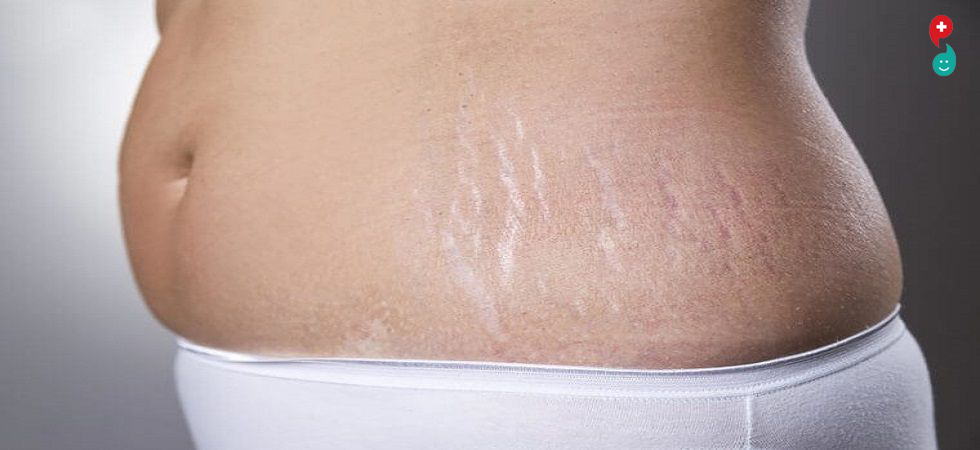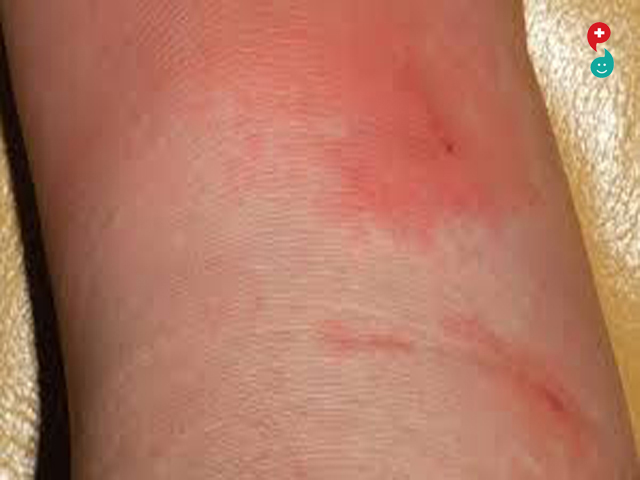Overview
Cellulitis (sel-u-LIE-tis) is a common, potentially serious bacterial skin infection. The affected skin appears swollen and red and is typically painful and warm to the touch.
Cellulitis usually affects the skin on the lower legs, but it can occur in the face, arms and other areas. It occurs when a crack or break in your skin allows bacteria to enter.
Left untreated, the infection can spread to your lymph nodes and bloodstream and rapidly become life-threatening. It isn't usually spread from person to person.
Symptoms
Possible signs and symptoms of cellulitis, which usually occur on one side of the body, include:
Red area of skin that tends to expand
Swelling
Tenderness
Pain
Warmth
Fever
Red spots
Blisters
Skin dimpling
When to see a doctor
It's important to identify and treat cellulitis early because the condition can spread rapidly throughout your body.
Seek emergency care if:
You have a red, swollen, tender rash or a rash that's changing rapidly
You have a fever
See your doctor, preferably that day, if:
You have a rash that's red, swollen, tender and warm — and it's expanding — but without fever
Causes
Cellulitis occurs when bacteria, most commonly streptococcus and staphylococcus, enter through a crack or break in your skin. The incidence of a more serious staphylococcus infection called methicillin-resistant Staphylococcus aureus (MRSA) is increasing.
Although cellulitis can occur anywhere on your body, the most common location is the lower leg. Bacteria are most likely to enter disrupted areas of skin, such as where you've had recent surgery, cuts, puncture wounds, an ulcer, athlete's foot or dermatitis.
Animal bites can cause cellulitis. Bacteria can also enter through areas of dry, flaky skin or swollen skin.
Risk factors
Several factors put you at increased risk of cellulitis:
Injury. Any cut, fracture, burn or scrape gives bacteria an entry point.
Weakened immune system. Conditions that weaken your immune system — such as diabetes, leukemia and HIV/AIDS — leave you more susceptible to infections. Certain medications also can weaken your immune system.
Skin conditions. Conditions such as eczema, athlete's foot and shingles can cause breaks in the skin, which give bacteria an entry point.
Chronic swelling of your arms or legs (lymphedema). This condition sometimes follows surgery.
History of cellulitis. Having had cellulitis before makes you prone to develop it again.
Obesity. Being overweight or obese increases your risk of developing cellulitis.
Complications
Recurrent episodes of cellulitis may damage the lymphatic drainage system and cause chronic swelling of the affected limb.
Rarely, the infection can spread to the deep layer of tissue called the fascial lining. Necrotizing fasciitis is an example of a deep-layer infection. It's an extreme emergency.
Prevention
If your cellulitis recurs, your doctor may recommend preventive antibiotics. To help prevent cellulitis and other infections, take these precautions when you have a skin wound:
Wash your wound daily with soap and water. Do this gently as part of your normal bathing.
Apply a protective cream or ointment. For most surface wounds, an over-the-counter ointment (Vaseline, Polysporin, others) provides adequate protection.
Cover your wound with a bandage. Change bandages at least daily.
Watch for signs of infection. Redness, pain and drainage all signal possible infection and the need for medical evaluation.
People with diabetes and those with poor circulation need to take extra precautions to prevent skin injury. Good skin care measures include the following:
Inspect your feet daily. Regularly check your feet for signs of injury so you can catch infections early.
Moisturize your skin regularly. Lubricating your skin helps prevent cracking and peeling. Do not apply moisturizer to open sores.
Trim your fingernails and toenails carefully. Take care not to injure the surrounding skin.
Protect your hands and feet. Wear appropriate footwear and gloves.
Promptly treat infections on the skin's surface (superficial), such as athlete's foot. Superficial skin infections can easily spread from person to person. Don't wait to start treatment.
It usually affects the buttocks and thighs but can also occur in other areas. Cellulite occurs when fat deposits push through the connective tissue beneath the skin.
Fast facts about cellulite
Between 80 and 90 percent of women will probably experience cellulite.
Cellulite is also known as orange-peel skin, due to its texture.
Numerous treatments available, but the effect is mostly temporary.
A diet low in fat, smoking cessation, and an active lifestyle may help reduce the incidence cellulite.
What is cellulite?
Cellulite
Cellulite is also known as orange-peel skin due to its appearance and affects 80 to 90 percent of women.
Cellulite is a term for the formation of lumps and dimples in the skin.
Common names for cellulite are orange-peel skin, cottage-cheese skin, hail damage, and the mattress phenomenon.
Cellulite can affect both men and women, but it is more common in females, due to the different distributions of fat, muscle, and connective tissue.
Between 80 and 90 percent of women may experience cellulite at some point in their lives.
Grades of cellulite
A cellulite severity scale, published in 2009, ranks the condition using three grades:
Grade 1, or mild: There is an "orange-peel" appearance, with between 1 and 4 superficial depressions, and a slightly "draped" or sagging appearance to the skin.
Grade 2, or moderate: There are between five and nine medium-depth depressions, a "cottage cheese" appearance, and the skin appears moderately draped.
Grade 3, or severe: There is a "mattress" appearance, with 10 or more deep depressions, and the skin is severely draped.
Causes
The exact cause of cellulite is unknown, but it appears to result from an interaction between the connective tissue in the dermatological layer that lies below the surface of the skin, and the layer of fat that is just below it.
In women, the fat cells and connective tissue in this layer are arranged vertically.
If the fat cells protrude into the layer of skin, this gives the appearance of cellulite.
In men, the tissue has a criss-cross structure, which may explain why are less likely to have cellulite than women.
Some other factors appear to be linked to the chance of having cellulite.
Hormonal factors and age
Hormones likely play an important role in cellulite development. Estrogen, insulin, noradrenaline, thyroid hormones, and prolactin are part of the cellulite production process.
One theory is that as estrogen in women decreases in the approach to menopause, blood flow to the connective tissue under the skin also decreases.
Lower circulation means less oxygen in the area, resulting in lower collagen production. Fat cells also enlarge as estrogen levels fall.
These factors combine to makes the fat deposits more visible. As the fat under the skin protrudes through weakening connective tissue, the familiar dimpling effect results.
Age also causes the skin to becomes less elastic, thinner, and more likely to sag. This increases the chance of cellulite developing.
चेहऱ्याचा सेल्युलिटिस लक्षण
खालील वैशिष्ट्ये चेहऱ्याचा सेल्युलिटिस दर्शवितात:
- ताप
- प्रभावित क्षेत्रातील वेदना किंवा कोमलता
- त्वचा फोड
- लाळपणाच्या क्षेत्रामध्ये उबदारपणा
- मळमळ
- उलट्या
चेहऱ्याचा सेल्युलिटिस कोणतीही शारीरिक लक्षणे दर्शवत नसेल तरीही रुग्णांमध्ये उपस्थित राहू शकतो.
चेहऱ्याचा सेल्युलिटिस चे साधारण कारण
चेहऱ्याचा सेल्युलिटिस चे साधारण कारणे खालीलप्रमाणे आहेत:
- बीटा हाइमलायटिक स्ट्रेप्टोकॉक्सी (बीएचएस) संक्रमण
- स्टॅफिलोकोकस ऑरियस संक्रमण
चेहऱ्याचा सेल्युलिटिस साठी जोखिम घटक
खालील घटक चेहऱ्याचा सेल्युलिटिस ची शक्यता वाढवू शकतात:
- डोके आणि मानांची शस्त्रक्रिया
- दंत संक्रमण
- सायनुसायटीस
- अप्पर रेस्पीरेटरी ट्रॅक्ट इन्फेक्शन्स
- आघात
चेहऱ्याचा सेल्युलिटिस टाळण्यासाठी
होय, चेहऱ्याचा सेल्युलिटिस प्रतिबंधित करणे संभव आहे. खालील गोष्टी करून प्रतिबंध करणे शक्य आहे:
- साबण आणि पाण्याने दररोज जखम स्वच्छ करा
- प्रभावित क्षेत्रावर संरक्षणात्मक मलई लागू करा
- संक्रमणाची लक्षणे पहा
चेहऱ्याचा सेल्युलिटिस ची शक्यता
प्रकरणांची संख्या
खालीलप्रमाणे जगभरात प्रत्येक वर्षी चेहऱ्याचा सेल्युलिटिस प्रकरणांची संख्या दिसली आहेत:
- 10 के - 50 के दरम्यान दुर्मिळ
सामान्य वयोगटातील जमाव
चेहऱ्याचा सेल्युलिटिस खालील वयोगटात सर्वात सामान्यपणे आढळते:
- वयोमर्यादा 45-64 वर्ष
सामान्य लिंग
चेहऱ्याचा सेल्युलिटिस कोणत्याही लिंगात होऊ शकतो.
प्रयोगशाळेतील चाचण्या आणि कार्यपध्दती चेहऱ्याचा सेल्युलिटिस चे निदान करण्यासाठी
प्रयोगशाळेतील चाचण्या आणि प्रक्रियांचा वापर चेहऱ्याचा सेल्युलिटिस शोधण्यासाठी केला जातो:
- फेशियल सीटी स्कॅन (संगणित टोमोग्राफी): अॅनेरोबिक सेल्युलिटिसचे निदान करण्यात मदत करते
उपचार न केल्यास चेहऱ्याचा सेल्युलिटिस च्या अधिक समस्या
होय, जर उपचार न केल्यास चेहऱ्याचा सेल्युलिटिस गुंतागुंतीचा होतो. चेहऱ्याचा सेल्युलिटिस वर उपचार न केल्यास, उद्भवणार्या गुंतागुंती आणि समस्यांची सूची खाली दिली आहे:
- फोड निर्मिती
चेहऱ्याचा सेल्युलिटिस साठी स्वत: घ्यावयाचि काळजी
खालीलप्रमाणे आत्म-काळजी किंवा जीवनशैलीत बदल चेहऱ्याचा सेल्युलिटिस च्या उपचार किंवा व्यवस्थापनास मदत करू शकतात:
- प्रभावित क्षेत्रावर थंड कापड ठेवा: प्रभावित क्षेत्राला आराम देते
चेहऱ्याचा सेल्युलिटिस उपचारांची वेळ
प्रत्येक रुग्णाच्या उपचारांकरिता वेळ-कालावधी भिन्न असू शकते, तज्ञांच्या पर्यवेक्षणानुसार योग्यरित्या उपचार केल्यास चेहऱ्याचा सेल्युलिटिस निराकरण करण्यासाठी विशिष्ट कालावधी लागतो:
- 1 - 4 आठवडे

MPTh, Cardiovascular And Pulmonary Physiotherapist Neuro Physiotherapist, 1 yrs, Pune










